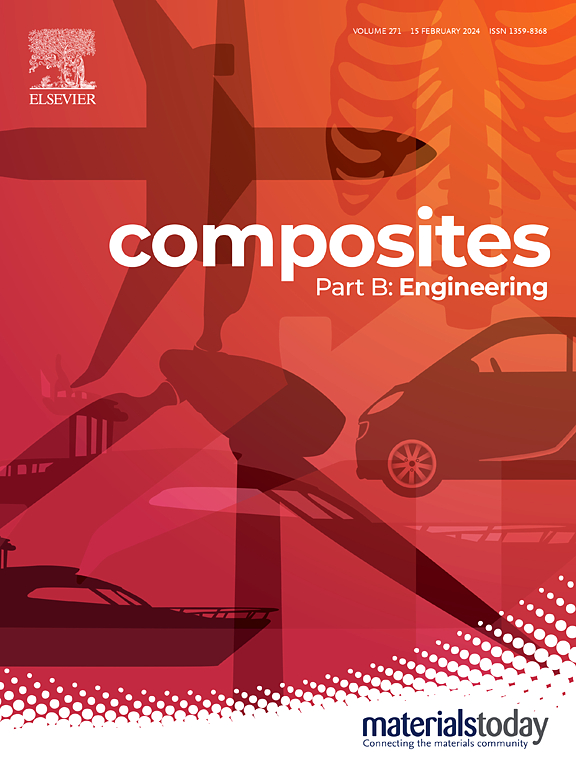纳米颗粒稳定二氧化碳泡沫:改善泡沫混凝土的水化、碳化和孔隙结构
IF 12.7
1区 材料科学
Q1 ENGINEERING, MULTIDISCIPLINARY
引用次数: 0
摘要
本研究采用纳米二氧化硅(NS)和纳米碳酸钙(NC)来稳定二氧化碳泡沫,随后将其用于生产二氧化碳泡沫混凝土(CFC)。研究了不同剂量的NS和NC对CO2泡沫特性及CFC性能和微观结构的影响。NS和NC的掺入显著增强了CO2泡沫的稳定性,其中NS和NC的掺入量分别为1%和1.5%时泡沫稳定性最佳。随着纳米颗粒含量的增加,新鲜CFC浆料的流动性逐渐下降。此外,当泡沫达到最佳稳定状态时,CFC的强度平均可提高36%,二氧化碳吸收量平均可提高1.8%。NS由于晶核效应和火山灰效应,同时促进了水化和碳酸化过程。这种双重作用有效地填补了孔壁上存在的缺陷,提高了强度。而NC则作为碳酸钙形成的成核位点效应,进一步推进了碳酸化过程,增强了孔壁的强度。以上作用不同程度地显著减小了CFC的孔喉半径、孔喉长度和连通孔数,优化了CFC的孔径分布、均匀性和球形度,从而降低了CFC的吸水率,提高了CFC的力学性能。本文章由计算机程序翻译,如有差异,请以英文原文为准。
Nanoparticle stabilized carbon dioxide foam: Improving hydration, carbonation and pore structure of foamed concrete
This study employed nano-silica (NS) and nano-calcium carbonate (NC) to stabilize CO2 foam, which was subsequently employed in the production of CO2 foamed concrete (CFC). The impacts of varying dosages of NS and NC on the characteristics of CO2 foam and the properties and microstructure of CFC were investigated. The incorporation of NS and NC significantly enhanced the stability of CO2 foam, with optimal foam stability achieved at content of 1 % for NS and 1.5 % for NC, respectively. The fluidity of fresh CFC paste exhibited a gradual decline as the content of nanoparticles increases. In addition, when the foam was optimal stable, the strength of CFC can be increased by 36 % and CO2 uptake by 1.8 % on average. NS owing to its crystal nucleus effect and volcanic ash effect, concurrently facilitated both hydration and carbonation processes. This dual action effectively filled the defects present on the pore walls and enhanced the strength. Whereas NC acted as a nucleation site effect for calcium carbonate formation, further advancing the carbonation process and reinforcing the strength of the pore walls. Above effects to varying degrees significantly reduced the pore throat radius, length and the number of interconnected pores of CFC, and optimized the pore size distribution, uniformity and sphericity, thereby reducing the water absorption rate of CFC and enhancing its mechanical properties.
求助全文
通过发布文献求助,成功后即可免费获取论文全文。
去求助
来源期刊

Composites Part B: Engineering
工程技术-材料科学:复合
CiteScore
24.40
自引率
11.50%
发文量
784
审稿时长
21 days
期刊介绍:
Composites Part B: Engineering is a journal that publishes impactful research of high quality on composite materials. This research is supported by fundamental mechanics and materials science and engineering approaches. The targeted research can cover a wide range of length scales, ranging from nano to micro and meso, and even to the full product and structure level. The journal specifically focuses on engineering applications that involve high performance composites. These applications can range from low volume and high cost to high volume and low cost composite development.
The main goal of the journal is to provide a platform for the prompt publication of original and high quality research. The emphasis is on design, development, modeling, validation, and manufacturing of engineering details and concepts. The journal welcomes both basic research papers and proposals for review articles. Authors are encouraged to address challenges across various application areas. These areas include, but are not limited to, aerospace, automotive, and other surface transportation. The journal also covers energy-related applications, with a focus on renewable energy. Other application areas include infrastructure, off-shore and maritime projects, health care technology, and recreational products.
 求助内容:
求助内容: 应助结果提醒方式:
应助结果提醒方式:


